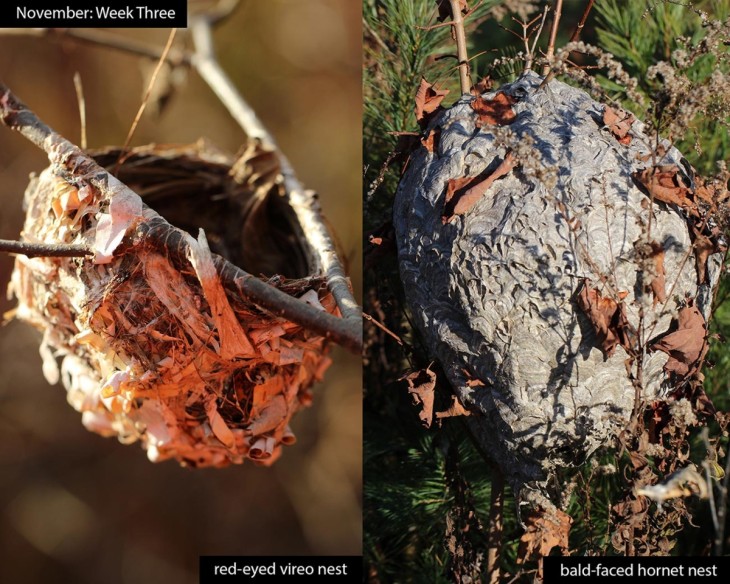This week in the woods, we can take a closer look at some vacated nests, now more visible among the bare branches and withered greenery.
We found this red-eyed vireo nest in Lyme, New Hampshire, in some edge habitat where marsh, field, and woods meet. While we may typically see male red-eyed vireos singing in the overstory during the summer breeding season, females often build nests only a few feet from the ground. The nests appear as tidy cups in the horizontal, Y-shaped forks of deciduous trees or shrubs and, unlike most of our other songbirds’ nests, hang below the hosting limbs. (To learn how to identify these nests and others, read Bernd Heinrich’s article “Which Bird Made That Nest?” from the Winter 2009 issue of Northern Woodlands.)
For construction materials, the female often uses spider and caterpillar webs, pine needles, and birch bark, all visible in the photo. Other common nesting materials include grapevine, grasses, roots, and paper from the nests of bald-faced hornets and other kinds of wasps. Wasp nest materials most often appear on the outside of red-eyed vireo nests, suggesting a signaling rather than structural purpose. As Mary Holland posits in a post for her Naturally Curious blog, these materials may ward off would-be predators that perceive the vireo’s nest as an active wasp nest.
We also found a bald-faced hornet nest this week, on a sugar maple sapling in Fairlee, Vermont, in a forest opening pioneered by white pine. These aerial yellowjacket wasps (not true hornets) create their gray, paper-like nest material by combining their saliva with wood, bark, and other fibrous plant matter. Queens begin the nests as single chambers with long, downward-facing entrance tubes, and workers grow them over the course of the summer into sizable, cone- or egg-shaped structures like this one. Three or four envelopes of paper cover combs with larvae and provide shelter for hundreds of yellowjackets. Arched openings appear in the outside layer, while the most prominent entrance shows at the bottom. In the autumn, the mother queen lays her last eggs – males and reproductive females rather than infertile female drones. These offspring disperse and mate, and the males die soon thereafter. The original queen and workers die around the time of first frost, and the nest will not be used again. The newly fertilized queens (the colony’s only survivors) spend the winter dormant in holes in the ground, tree crevices, and rock piles and emerge in the spring to build their own nests and start the cycle anew.
What have you noticed in the woods this week? Submit a recent photo for possible inclusion in our monthly online Reader Photo Gallery.


